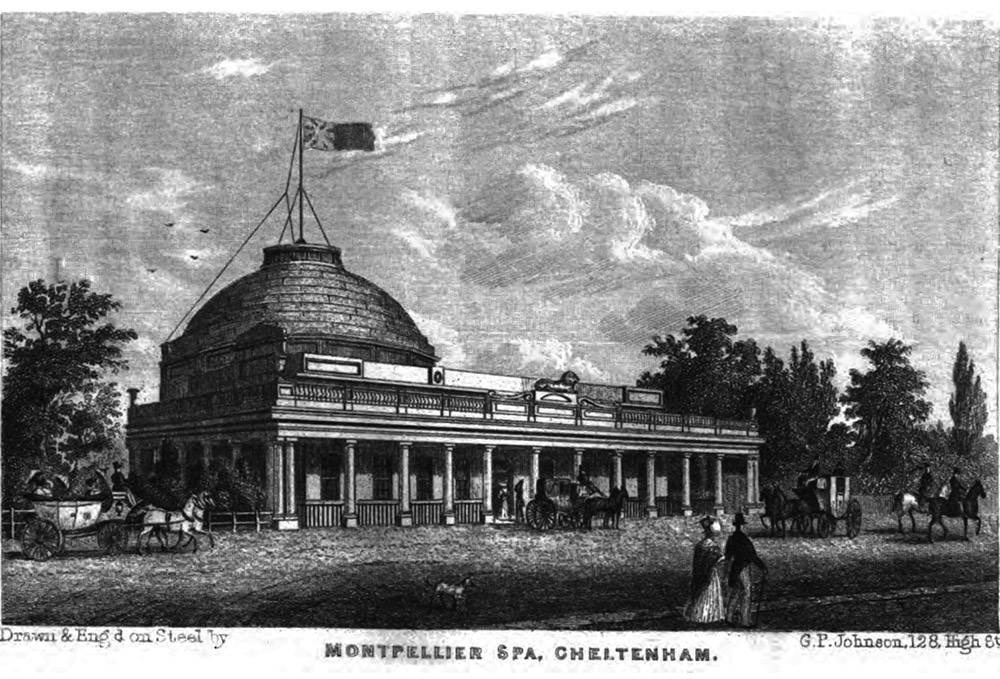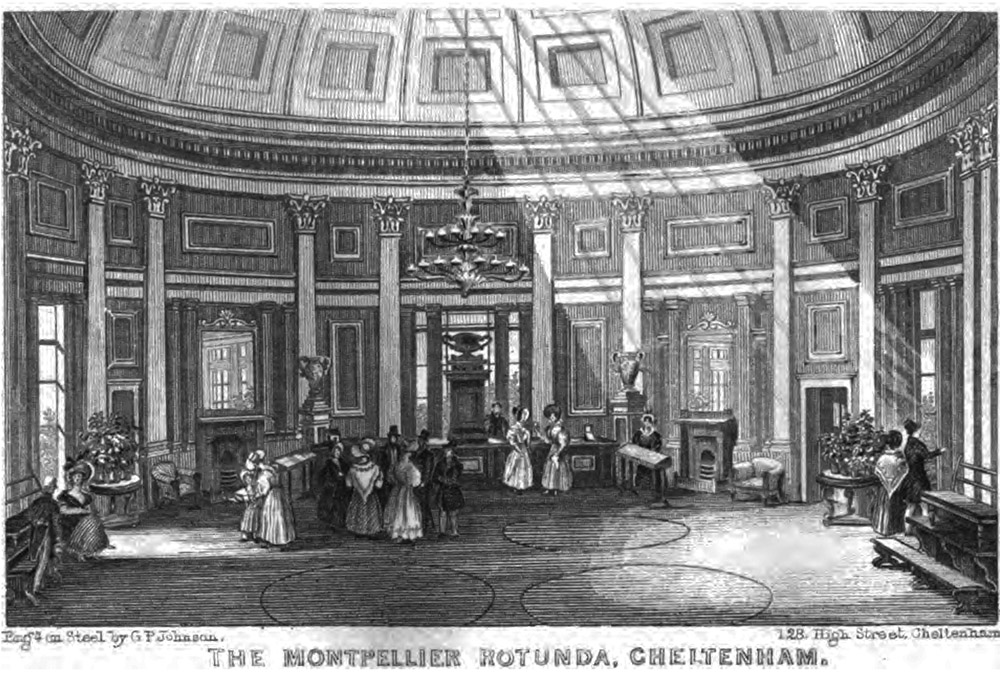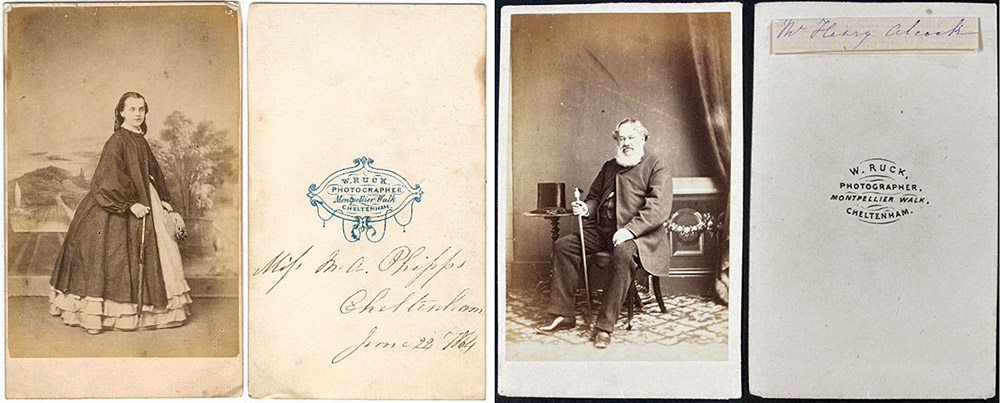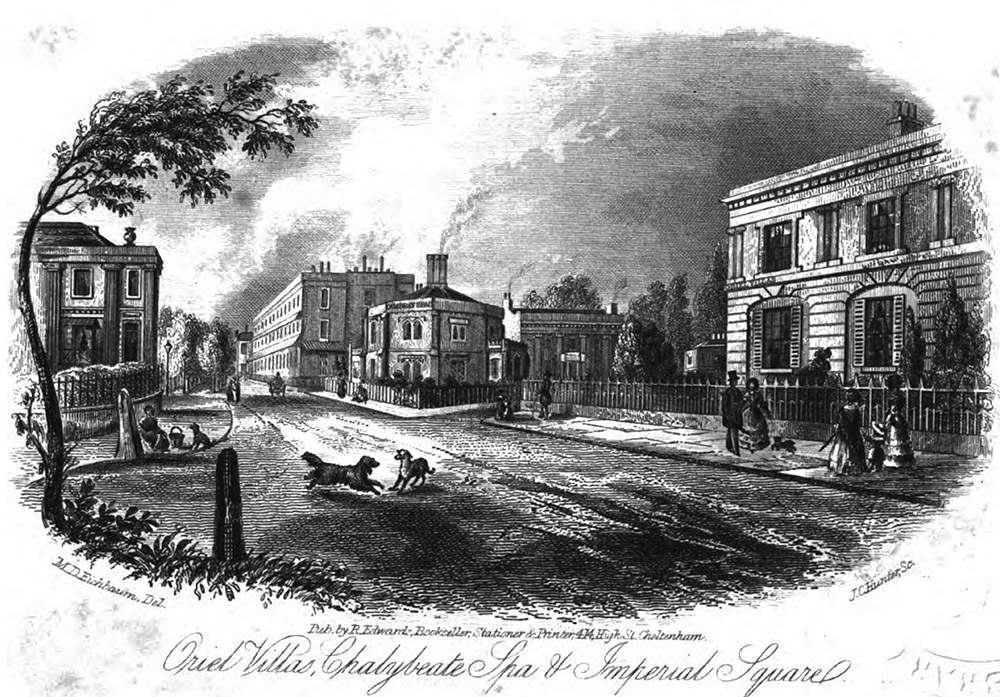William Ruck, ca. 1813 - 1886
by Brian Stevenson
last updated September, 2023
To date, only a single microscope is known that is signed by Ruck of Cheltenham, Gloucestershire, and he almost certainly did not actually manufacture it (Figure 1). He is included here as an example of microscopes that were sold wholesale to retailers who attached their own names, then sold to the public under the impression that the seller was the maker.
William Ruck was not an expert in working with either brass or glass. For most of his life, he operated mineral water spas, and administered “medical” electric muscle stimulation treatments to his spa clients. Ruck also sold battery-operated stimulation devices. From the mid-1850s until the mid-1860s, Ruck operated a photographic studio. Both his battery device shop and photographic studio would have attracted clientele who might be interested in apparatus such as microscopes. A well-known example of this is the London Stereographic Company, which was primarily a photography studio and stereograph shop, but also sold a wide range of microscopes, slides, and related optical apparatus.
The actual maker of the microscope shown in Figure 1 was Thomas D. King (1818-1894), of Bristol (Figure 2). He manufactured microscopes and other scientific instruments between around 1850, when he acquired the business from his father, until around 1856/1858, when he filed for bankruptcy and the business was sold off.

Figure 1.
A microscope that is engraved “Ruck, Maker, Cheltenham”. However, William Ruck was not an expert in either optics or brasswork, and undoubtedly acquired this instrument from a wholesale manufacturer. Adapted for nonprofit, educational purposes from internet auction and retail sites.

Figure 2.
An identical microscope that was manufactured by Thomas D. King, of Bristol, ca. 1850-1858. The unique style of King’s microscope, and the proximity between King and Ruck, imply that King was the actual maker of the microscope shown in Figure 1. Images adapted for nonprofit, educational purposes from an internet auction site.
Census records indicate that William Ruck was born around 1813, but are inconsistent in listing his birthplace as either Gloucestershire or Ross, Hertsfordshire.
The first firm evidence of William Ruck’s life appeared in the 1846 Edwards's New Cheltenham Guide, “Montpellier Baths: These Baths have long enjoyed public patronage, and the excellency of the arrangements, under the care of Mr. Ruck, a gentleman of high scientific attainments, will always secure their popularity, This establishment is situate in the Bath Road, at the top, or High Street end, and may be easily recognized by the lofty chimney contiguous, and which belongs to the Cheltenham Salts Manufactory, carried on in connection with it. These Baths are elegantly fitted up, twenty-five in number, and comprise every description, from the Hot Air, down to the Chalybeate Cold Plunging Bath.” (Figure 3).
From at least 1846 onward, Ruck advertised himself as a “medical galvanist” (Figures 4 and 5). He constructed and sold battery-operated devices for administering mild electrical shocks, which were thought to be beneficial to health. It is possible that Ruck’s shop included other scientific instrument, such as microscopes.
William Ruck married Elizabeth Day on September 30, 1848, at the parish church of St. Mary De Crypt, Gloucester.
Ruck lost control of the Montpellier Spa in 1856 (Figure 6). A legal notice stated that “Mr. Ruck … is under notice to quit at Michaelmas next”.
The 1857 Cheltenham Annuaire, which was issued at the end of 1856, listed “Ruck W., Photographist, &c., Montpellier Walk”, and a half-page advertisement (Figure 7). That year’s Harper’s Cheltenham Directory included, “Ruck, William, photographic artist, Montpellier walk; residence, Trevor house, Leckhampton”. The 1861 national census listed William, Elizabeth, and their five children as living in Leckhampton, supported by the efforts of two domestic servants. This makes it evident that Ruck’s finances were not substantially hurt by the loss of the Montpellier Spa. The 1863 Cheltenham Annuaire still included “Ruck, W., photographic portrait rooms, Montpellier Walk”.
As noted above, photographic studios of the time often sold microscopes and other scientific and optical equipment.
By 1870, William Ruck had taken on proprietorship of Cheltenham’s Cambray Spa. That year’s Cheltenham Annuaire included this entry, “Ruck W., Medical Galvanist, Cambray spa”.
In 1873, Ruck converted Cambray Spa “into a Turkish bath, where patrons could enjoy massage and a range of vapour, mercurial, sulphur, salt, alkaline, warm or cold, galvanic or electro chemical baths”.
The 1881 national census recorded William Ruck as “medical galvanist and bath keeper”.
William Ruck died at home at the Cambray Spa on September 11, 1886. His son, Frank, continued to operate the Cambry Spa until well into the 1900s.



Figure 3.
Views of the Montpellier Spa, Cheltenham, which was operated by William Ruck from at least 1846 until 1856. Images from “Edwards's New Cheltenham Guide” (1846) and “The Pictorial Hand-book for Cheltenham” (1851).

Figure 4.
1847 advertisement for William Ruck, Medical Galvanist, from “Hunt & Co.'s City of Gloucester and Cheltenham Directory & Court Guide”.

Figure 5.
1851 advertisement for William Ruck’s galvanic battery apparatus, from Edwin Lee’s “Cheltenham and Its Resources, Mineral Waters, Climate, Etc.”

Figure 6.
1856 notice that William Ruck had lost control of Montpellier Spa, from “The Law Times”.

Figure 7.
1857 advertisement from “The Cheltenham Annuaire”.

Figure 8.
ca. 1857-1865 cartes-de-visite (CDV) photographs by William Ruck. Adapted for nonprofit, educational purposes from internet sale and auction sites.

Figure 9.
William Ruck had acquired ownership of Cheltenham’s Cambray Spa by 1870. From the 1870 “Cheltenham Annuaire”.


Figure 10.
Images of Cambray Spa, Cheltenham, adapted for educational, nonprofit purposes.

Figure 11.
ca. 1890 advertisement for Cambray Spa, evidently from after William Ruck’s death, as his son, Frank, is listed as the proprietor. Adapted for nonprofit, educational purposes from https://agmlib.cheltenham.gov.uk/Details/collect/17653
Acknowledgement
Thank you to Joe Zeligs, for helpful insights.
Resources
The Cheltenham Annuaire (1857) page 134 and advertisements
The Cheltenham Annuaire (1863) page 245
The Cheltenham Annuaire (1870) page 218 and xxvi
Elder, David (2014) Cheltenham Heritage Walks, Amberley, Stroud, Gloucestershire
England census and other records, accessed through ancestry.com
Goding, John (1846) Edwards's New Cheltenham Guide, pages 11-12
Harper's Cheltenham Directory (1857) page 141
Hunt & Co.'s City of Gloucester and Cheltenham Directory & Court Guide (1847) page 88 and advertising section
Kelly's Directory of the County of Gloucester (1914) “Cambray Spa Turkish Baths (Frank Ruck, propr.), Rodney rd. Cheltenham”, page 446
The Law Times (1856) April 26
Lee, Edwin (1851) Cheltenham and Its Resources, Mineral Waters, Climate, Etc., advertisement from William Ruck
The Pictorial Hand-book for Cheltenham (1851)
Probate of the will of William Ruck (1886) “Ruck, William. 5 October, The Will with two Codicils of William Ruck late of Cambray Spa Cheltenham in the County of Gloucester Medical Galvinist and Turkish Bath Proprietor who died 11 September 1886 at Cambray Spa was proved at Gloucester by Richard Philip Woodman of 9 Promenade-villas Cheltenham China Merchant and Frank Ruck of Cambray Spa Turkish Bath Manager the Son the Executors. Personal Estate £373 2s 8d”, accessed through ancestry.com













